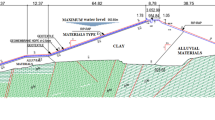Conclusions
-
1.
The three-dimensional conditions of a site have an effect not only on the formation of vertical stresses in an earth dam (development of the arching effect) but also on a number of other aspects of its behavior. Therefore, despite the absence of the arching effect, the stress-strain state and stability of an earth dam with a height of 75 m in a wide site (K s ≈ 4) is to a considerable extent determined by the 3D conditions.
-
2.
Generalization of the results of calculations of the 3D SSS of certain dams of various designs under conditions of various sites shows that:
-
All aspects of the three-dimensional behavior of the structure (stress state, movements, stability) are affected by the absolute values of the dimensions of the structure and site and not by their relationship (site coefficient, etc.). Therefore, for characterizing the 3D conditions of a site it is necessary to indicate not only the site coefficient but also the characteristic dimension of the dam, the height or crest length;
-
For earth dams with a height greater than 70–80 m with a site coefficientK s ≈ 4 the effect of three-dimensionality on the formation of vertical stresses can be neglected and they can be estimated from the results of solving two-dimensional problems;
-
In the dam body occur “opposing movements” of the soil masses from the walls toward the middle section. This effect is most developed when the slope angle of the walls is 45° and markedly decreases with increase of the angle more than 60° or decrease less than 30°;
-
The effect of the “opposing movements” causes an increase of the level of transverse stresses, which depends not only on the wall slope angle (maximum for 45°) but also on the width of the site: the greater the width of the site, the smaller the effect;
-
In turn, an increase of the level of transverse stresses brings the soil of the dam body to a state closer to uniform compression, which reduces the deformation of the dam and increases its stability. The increase of stability is most considerable for wall slope angles 30–60° with a site coefficient (according to available data) of not more than 4.
-
3.
The effect of the 3D conditions of the site on the behavior of earth dams is quite considerable and diverse and occurs for rather wide sites. This must be taken into account when searching for optimal designs of earth dams based on an analysis of their stress-strain state and stability.
-
4.
The characteristics of the absorption of loads by the structural elements of an earth dam with an adverse facing determine the considerable unloading in the shoulder and under the blanket, which without taking appropriate engineering measures (drawdown of the upper pool level and increase of the surcharge of the facing) leads to disturbance of its stability. Therefore, the use of dams of such type in hydrotechnical construction practice is undesirable.
Similar content being viewed by others
Literature cited
SNiP 2.06.05-84. Earth Dams [in Russian].
L. N. Rasskazov, Yu. M. Sysoev, and A. A. Belyakov, “Characteristics of the stress-strain state of a high earth and rock dam on a compressible foundation,” Énerg. Stroit., No. 5 (1979).
L. N. Rasskazov and Yu. M. Sysoev, “Factor analysis when selecting the designs of earth and rock dams,” Énerg. Stroit., No. 12 (1978).
L. N. Rasskazov and I. L. Orekhova, “Optimization of the designs of earth dams,” Gidrotekh. Stroit., No. 7 (1985).
L. N. Rasskazov and A. A. Belyakov, “Stability of gravel dams with a grout core,” Gidrotekh. Stroit., No. 5 (1984).
L. N. Rasskazov and A. A. Belyakov, “Calculation of the three-dimensional stress-strain state of an earth and rock dam,” Gidrotekh. Stroit., No. 2 (1982).
A. A. Belyakov, “Performance of an earth dam with a reinforced-conrete facing,” Gidrotekh. Stroit., No. 8 (1985).
N. N. Maslov, Soil Mechanics in Construction Practice (Landslides and Their Control) [in Russian], Stroiizdat, Moscow (1977).
Additional information
Sites at which the ratio of the crest width of the dam to the height (“site coefficient”) exceeds 3–3.5 are traditionally called “wide”.
Translated from Gidrotekhnicheskoe Stroitel'stvo, No. 12, pp. 52–58, December, 1988.
Rights and permissions
About this article
Cite this article
Belyakov, A.A. Three-dimensional behavior of an earth dam at a wide site. Hydrotechnical Construction 22, 718–725 (1988). https://doi.org/10.1007/BF01429609
Issue Date:
DOI: https://doi.org/10.1007/BF01429609




